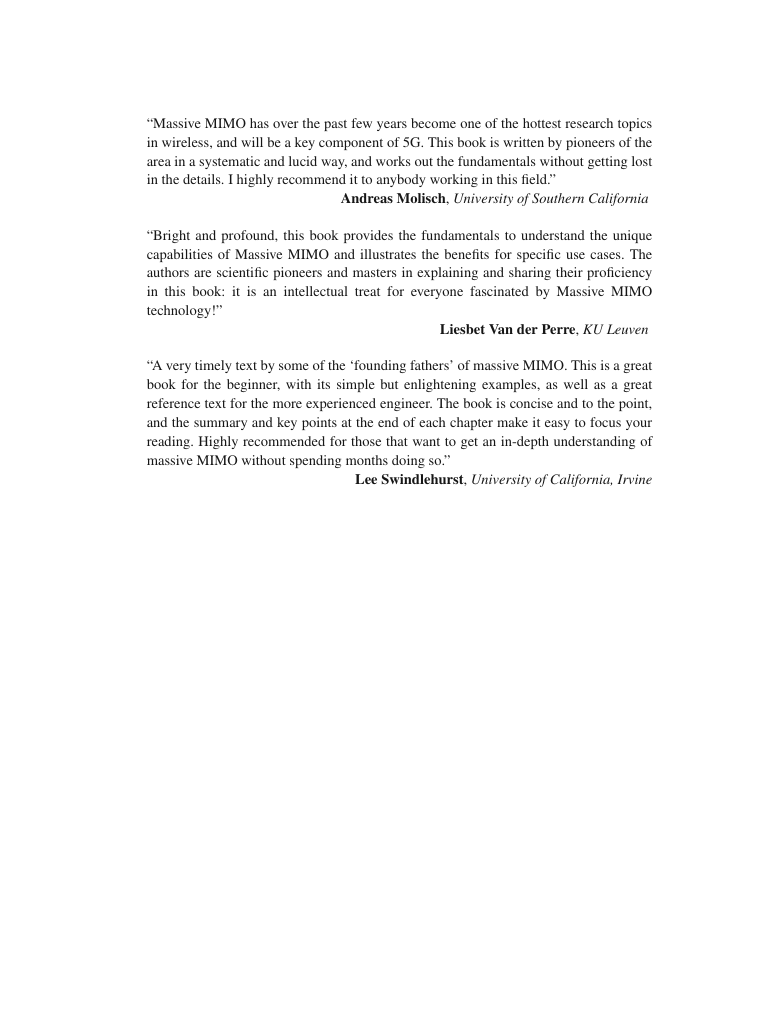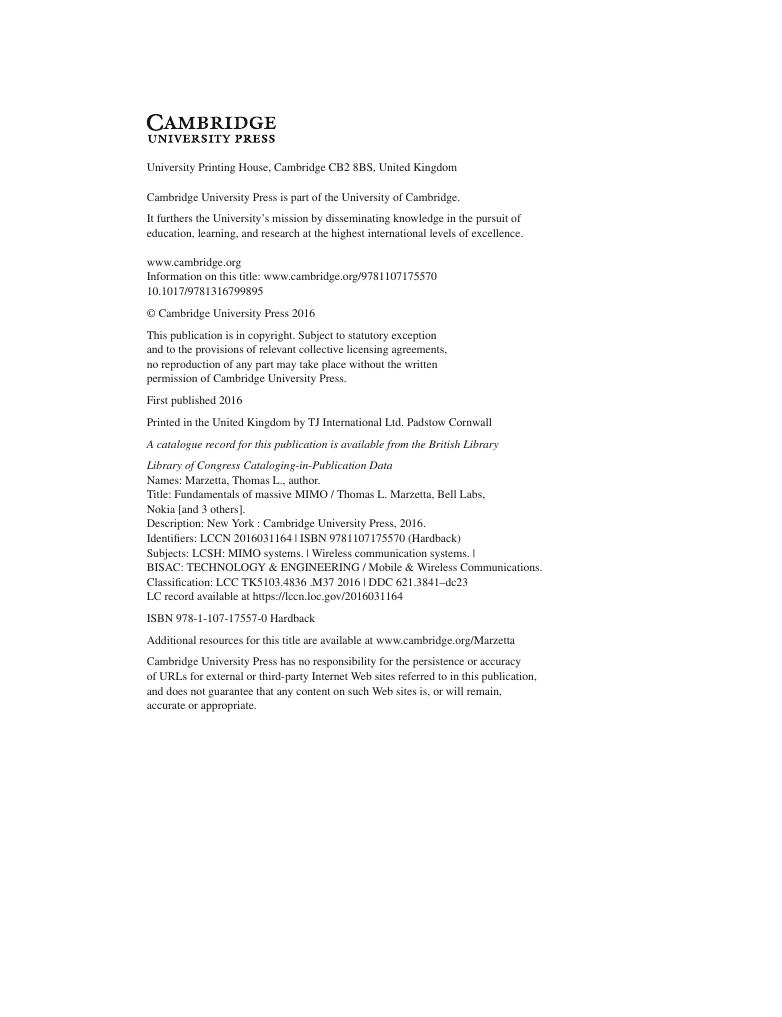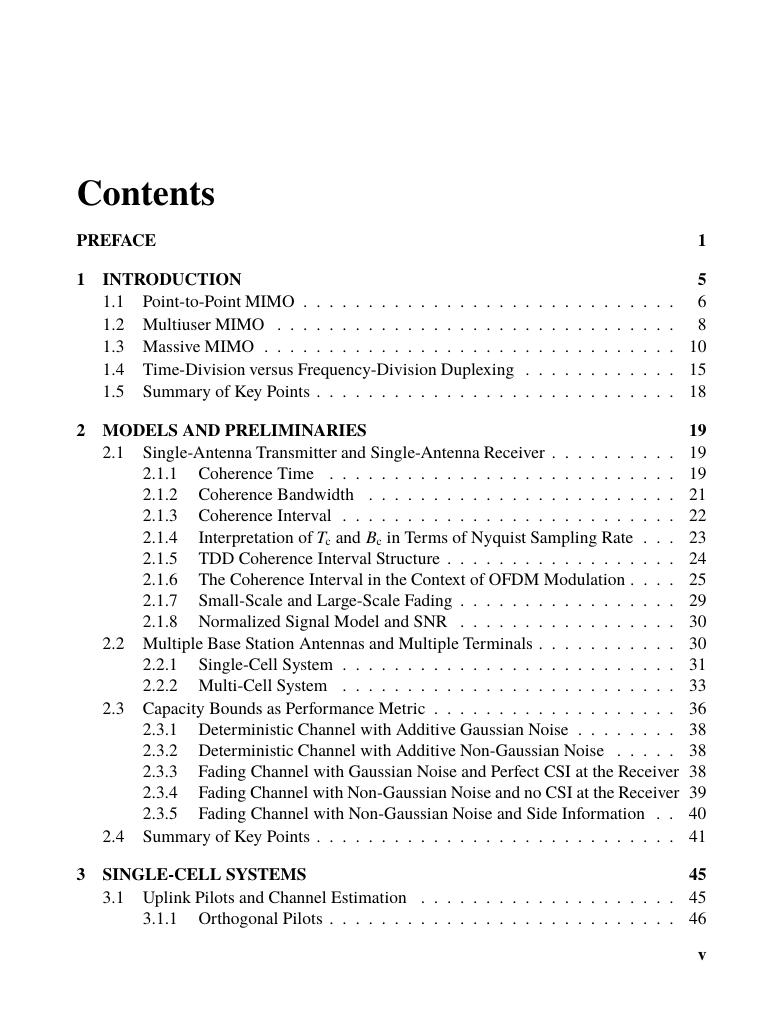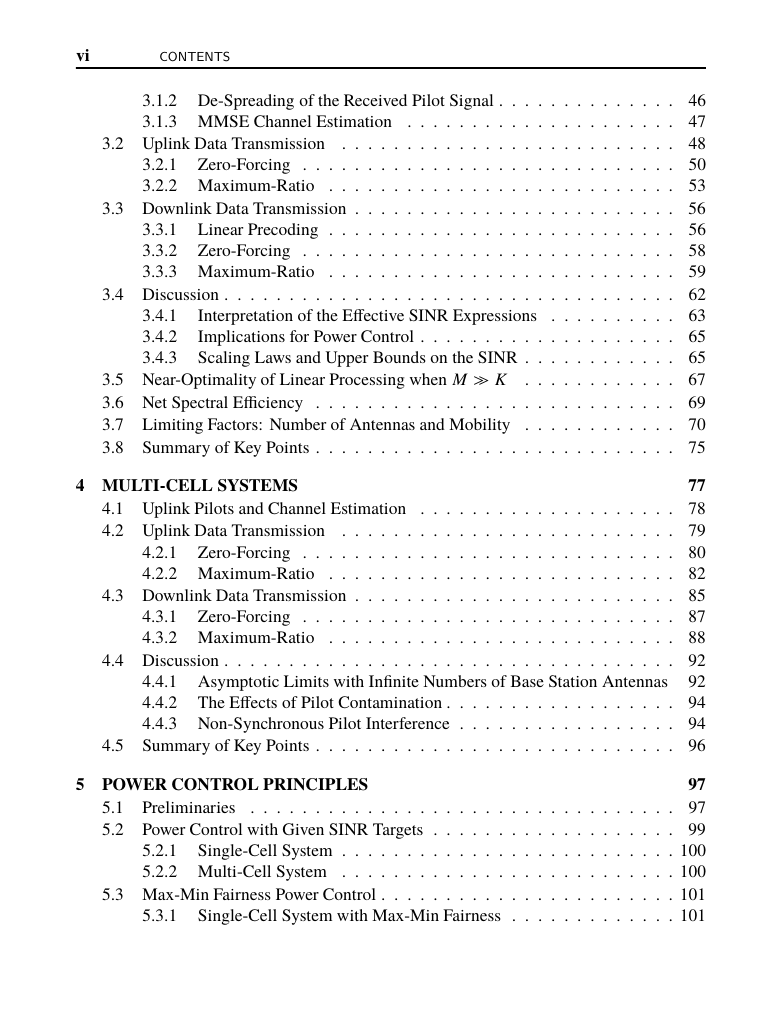�
Fundamentals of Massive MIMO
Written by pioneers of the concept, this is the first complete guide to the physical
and engineering principles of Massive MIMO. Assuming only a basic background
in communications and statistical signal processing, it will guide readers through
key topics in multi-cell systems such as propagation modeling, multiplexing and
de-multiplexing, channel estimation, power control, and performance evaluation. The
authors’ unique capacity-bounding approach will enable readers to carry out effective
system performance analyses and develop advanced Massive MIMO techniques and
algorithms. Numerous case studies, as well as problem sets and solutions accompanying
the book online, will help readers put knowledge into practice and acquire the skill set
needed to design and analyze complex wireless communication systems. Whether you
are a graduate student, researcher, or industry professional working in the field of
wireless communications, this will be an indispensable guide for years to come.
Thomas L. Marzetta is the originator of Massive MIMO. He is a Bell Labs Fellow at
Nokia and a Fellow of the IEEE, and previously worked at Schlumberger-Doll Research
and Nichols Research Corporation. He has received numerous recognitions and awards,
including the IEEE W. R. G. Baker Award (2015), the IEEE Communications Society
Stephen O. Rice Prize (2015), and the IEEE Guglielmo Marconi Prize Paper Award
(2013). He is the recipient of an Honorary Doctorate from Linköping University.
Erik G. Larsson is a Professor at Linköping University in Sweden and a Fellow of
the IEEE. He is the co-author of 120 journal papers and the textbook Space-Time
Block Coding for Wireless Communications (Cambridge, 2003). He currently serves as
Chair of the IEEE SPS Technical Committee for Signal Processing for Communications
and Networking (2015–2016). In both 2012 and 2014, he received the IEEE Signal
Processing Magazine Best Column Award, and in 2015 he was awarded the IEEE
Communications Society Stephen O. Rice Prize.
Hong Yang is a member of technical staff at Nokia Bell Labs’ Mathematics of Networks
and Communications Research Department, where he conducts research into wireless
communications networks. He has over fifteen years of industrial research and develop-
ment experience, and has previously worked in both the Department of Radio Frequency
Technology Systems Engineering and the Wireless Design Center at Alcatel-Lucent.
Hien Quoc Ngo is a researcher at Linköping University, Sweden. In 2015, he received the
IEEE Communications Society Stephen O. Rice Prize and the IEEE Sweden VT-COM-
IT Joint Chapter Best Student Journal Paper Award. He was also an IEEE Communica-
tions Letters exemplary reviewer in 2014 and an IEEE Transactions on Communications
exemplary reviewer in 2015.
“Massive MIMO has over the past few years become one of the hottest research topics
in wireless, and will be a key component of 5G. This book is written by pioneers of the
area in a systematic and lucid way, and works out the fundamentals without getting lost
in the details. I highly recommend it to anybody working in this field.”
Andreas Molisch, University of Southern California
“Bright and profound, this book provides the fundamentals to understand the unique
capabilities of Massive MIMO and illustrates the benefits for specific use cases. The
authors are scientific pioneers and masters in explaining and sharing their proficiency
in this book: it is an intellectual treat for everyone fascinated by Massive MIMO
technology!”
Liesbet Van der Perre, KU Leuven
“A very timely text by some of the ‘founding fathers’ of massive MIMO. This is a great
book for the beginner, with its simple but enlightening examples, as well as a great
reference text for the more experienced engineer. The book is concise and to the point,
and the summary and key points at the end of each chapter make it easy to focus your
reading. Highly recommended for those that want to get an in-depth understanding of
massive MIMO without spending months doing so.”
Lee Swindlehurst, University of California, Irvine
�
Fundamentals of Massive MIMO
Thomas L. Marzetta
Bell Labs, Nokia
Erik G. Larsson
Linköping University, Sweden
Hong Yang
Bell Labs, Nokia
Hien Quoc Ngo
Linköping University, Sweden
�
University Printing House, Cambridge CB2 8BS, United Kingdom
Cambridge University Press is part of the University of Cambridge.
It furthers the University’s mission by disseminating knowledge in the pursuit of
education, learning, and research at the highest international levels of excellence.
www.cambridge.org
Information on this title: www.cambridge.org/9781107175570
10.1017/9781316799895
© Cambridge University Press 2016
This publication is in copyright. Subject to statutory exception
and to the provisions of relevant collective licensing agreements,
no reproduction of any part may take place without the written
permission of Cambridge University Press.
First published 2016
Printed in the United Kingdom by TJ International Ltd. Padstow Cornwall
A catalogue record for this publication is available from the British Library
Library of Congress Cataloging-in-Publication Data
Names: Marzetta, Thomas L., author.
Title: Fundamentals of massive MIMO / Thomas L. Marzetta, Bell Labs,
Nokia [and 3 others].
Description: New York : Cambridge University Press, 2016.
Identifiers: LCCN 2016031164 | ISBN 9781107175570 (Hardback)
Subjects: LCSH: MIMO systems. | Wireless communication systems. |
BISAC: TECHNOLOGY & ENGINEERING / Mobile & Wireless Communications.
Classification: LCC TK5103.4836 .M37 2016 | DDC 621.3841–dc23
LC record available at https://lccn.loc.gov/2016031164
ISBN 978-1-107-17557-0 Hardback
Additional resources for this title are available at www.cambridge.org/Marzetta
Cambridge University Press has no responsibility for the persistence or accuracy
of URLs for external or third-party Internet Web sites referred to in this publication,
and does not guarantee that any content on such Web sites is, or will remain,
accurate or appropriate.
�
Contents
PREFACE
1 INTRODUCTION
1.1 Point-to-Point MIMO .
. .
.
1.2 Multiuser MIMO . .
. .
1.3 Massive MIMO .
. .
.
. .
1.4 Time-Division versus Frequency-Division Duplexing .
1.5 Summary of Key Points .
. .
. .
. .
. .
. .
. .
. .
. .
. .
. .
. .
. .
. .
. .
. .
. .
. .
.
.
.
.
.
.
.
.
.
.
.
.
.
.
.
.
.
.
.
.
.
.
.
.
.
.
.
1
5
6
. .
. .
8
. . 10
. . 15
. . 18
.
.
.
.
.
.
.
.
.
.
. .
. .
. .
. .
. .
.
.
.
.
.
. .
. .
. .
. .
. .
.
.
.
.
.
.
.
.
.
.
2 MODELS AND PRELIMINARIES
3 SINGLE-CELL SYSTEMS
3.1 Uplink Pilots and Channel Estimation . .
. .
3.1.1 Orthogonal Pilots . .
. .
.
.
.
.
.
. .
. .
.
.
.
.
. .
. .
.
.
.
.
. .
. .
.
.
. .
. .
.
.
.
.
45
. . 45
. . 46
v
.
.
.
.
.
.
.
.
.
.
.
.
.
.
.
.
.
.
.
.
.
.
.
.
. .
. .
.
.
.
.
.
.
.
.
. .
. .
. .
. .
. .
. .
. .
. .
. .
. .
. .
. .
. .
. .
. .
. .
. .
2.1 Single-Antenna Transmitter and Single-Antenna Receiver .
.
.
.
.
.
.
.
Interpretation of Tc and Bc in Terms of Nyquist Sampling Rate .
.
.
.
.
.
.
.
.
.
.
19
. . 19
. . 19
. . 21
. . 22
. . 23
. . 24
. . 25
. . 29
. . 30
. . 30
. . 31
. . 33
. . 36
. . 38
. . 38
Fading Channel with Gaussian Noise and Perfect CSI at the Receiver 38
Fading Channel with Non-Gaussian Noise and no CSI at the Receiver 39
Fading Channel with Non-Gaussian Noise and Side Information . . 40
. . 41
2.1.1 Coherence Time . .
. .
2.1.2 Coherence Bandwidth . .
2.1.3 Coherence Interval
. .
2.1.4
.
2.1.5 TDD Coherence Interval Structure .
2.1.6 The Coherence Interval in the Context of OFDM Modulation .
.
2.1.7
Small-Scale and Large-Scale Fading . .
2.1.8 Normalized Signal Model and SNR . .
.
.
.
.
.
.
.
. .
. .
. .
. .
. .
. .
. .
. .
. .
. .
. .
. .
2.3.1 Deterministic Channel with Additive Gaussian Noise .
. .
2.3.2 Deterministic Channel with Additive Non-Gaussian Noise .
2.3.3
2.3.4
2.3.5
.
.
2.2 Multiple Base Station Antennas and Multiple Terminals .
.
.
.
. .
. .
2.3 Capacity Bounds as Performance Metric .
2.2.1
Single-Cell System .
2.2.2 Multi-Cell System .
2.4 Summary of Key Points .
. .
. .
. .
. .
. .
. .
. .
. .
. .
. .
.
.
.
.
.
.
.
.
.
.
.
.
.
. .
. .
. .
. .
. .
. .
. .
. .
. .
.
.
.
.
.
.
.
.
.
.
.
.
.
.
.
.
.
.
.
.
.
.
.
.
.
.
.
.
.
.
.
.
�
vi
CONTENTS
3.2 Uplink Data Transmission .
3.2.1 Zero-Forcing .
. .
3.2.2 Maximum-Ratio . .
3.1.2 De-Spreading of the Received Pilot Signal .
3.1.3 MMSE Channel Estimation .
.
.
.
.
.
.
.
.
.
.
.
.
.
.
.
.
.
.
.
.
3.3 Downlink Data Transmission .
.
.
.
.
3.3.1 Linear Precoding . .
3.3.2 Zero-Forcing .
. .
3.3.3 Maximum-Ratio . .
. .
. .
. .
. .
. .
. .
. .
. .
. .
. .
. .
. .
. .
. .
. .
. .
. .
. .
. .
. .
. .
. .
. .
. .
. .
. .
. .
3.4 Discussion .
.
.
.
.
.
.
.
.
.
.
.
.
.
.
.
.
.
.
.
.
.
.
.
.
.
.
. .
. .
.
.
.
.
.
. .
. .
. .
. .
. .
. .
. .
. .
. .
. .
3.4.1
3.4.2
3.4.3
Interpretation of the Effective SINR Expressions
. .
Implications for Power Control . .
Scaling Laws and Upper Bounds on the SINR .
. .
.
.
.
3.5 Near-Optimality of Linear Processing when M K .
. .
3.6 Net Spectral Efficiency .
3.7 Limiting Factors: Number of Antennas and Mobility .
3.8 Summary of Key Points .
. .
. .
. .
. .
. .
. .
. .
. .
. .
.
.
.
.
.
.
.
.
.
.
.
.
4 MULTI-CELL SYSTEMS
4.1 Uplink Pilots and Channel Estimation . .
. .
4.2 Uplink Data Transmission .
. .
. .
4.2.1 Zero-Forcing .
. .
4.2.2 Maximum-Ratio . .
. .
. .
. .
. .
.
.
.
4.3 Downlink Data Transmission .
.
.
.
4.3.1 Zero-Forcing .
. .
4.3.2 Maximum-Ratio . .
. .
. .
. .
. .
. .
. .
. .
. .
4.4 Discussion .
.
.
.
.
.
.
.
.
.
.
.
.
.
.
. .
. .
.
.
.
.
.
.
.
.
.
.
.
.
.
. .
. .
. .
. .
. .
. .
. .
. .
.
.
.
.
.
.
.
.
.
.
.
.
.
.
.
.
. .
. .
. .
. .
. .
. .
. .
. .
.
.
.
.
.
.
.
.
.
.
.
.
.
.
.
.
.
.
.
.
.
.
.
.
.
.
.
.
.
.
.
.
.
.
.
.
.
.
.
.
.
.
.
.
.
.
.
.
.
. .
. .
. .
. .
. .
. .
. .
. .
. .
. .
. .
. .
. .
. .
. .
. .
. .
. .
. .
. .
. .
. .
. .
. .
. .
.
.
.
.
.
.
.
.
.
.
.
.
.
.
.
.
.
.
.
.
.
.
.
.
.
. .
. .
. .
. .
. .
. .
. .
. .
. .
. .
. .
. .
. .
. .
. .
. .
. .
. .
. .
. .
. .
. .
. .
. .
. .
.
.
.
.
.
.
.
.
.
.
.
.
.
.
.
.
.
.
.
.
.
.
.
.
.
.
.
.
.
.
.
.
.
.
.
.
.
.
.
.
.
.
.
.
.
.
.
.
.
.
. . 46
. . 47
. . 48
. . 50
. . 53
. . 56
. . 56
. . 58
. . 59
. . 62
. . 63
. . 65
. . 65
. . 67
. . 69
. . 70
. . 75
77
. . 78
. . 79
. . 80
. . 82
. . 85
. . 87
. . 88
. . 92
92
. . 94
. . 94
. . 96
4.4.1 Asymptotic Limits with Infinite Numbers of Base Station Antennas
. .
4.4.2 The Effects of Pilot Contamination .
4.4.3 Non-Synchronous Pilot Interference . .
. .
. .
. .
. .
. .
. .
. .
. .
. .
. .
. .
. .
. .
.
.
.
.
.
.
.
.
.
.
.
.
.
.
.
.
.
.
.
.
.
4.5 Summary of Key Points .
.
.
.
.
5 POWER CONTROL PRINCIPLES
.
.
.
.
.
.
.
. .
. .
. .
5.1 Preliminaries
. .
5.2 Power Control with Given SINR Targets .
. .
. .
. .
. .
. .
. .
. .
. .
Single-Cell System with Max-Min Fairness . .
. .
. .
5.3 Max-Min Fairness Power Control .
Single-Cell System .
5.2.1
5.2.2 Multi-Cell System .
. .
. .
. .
. .
. .
5.3.1
.
.
.
.
.
.
.
.
.
.
.
.
.
.
.
.
.
.
.
.
.
.
.
.
.
.
.
.
.
.
.
.
.
.
.
. .
. .
. .
. .
. .
. .
.
.
.
.
.
.
. .
. .
. .
. .
. .
. .
.
.
.
.
.
.
.
.
.
.
.
.
97
. . 97
. . 99
. . 100
. . 100
. . 101
. . 101
�
CONTENTS
vii
5.3.2 Multi-Cell Systems with Network-Wide Max-Min Fairness .
5.3.3 Negligible Coherent Interference and Full Power
. .
. .
5.3.4 Uniformly Good Service .
. .
. .
. .
. .
. .
. .
. .
. .
. .
. .
. .
. .
.
.
.
.
.
.
5.4 Summary of Key Points .
.
.
.
.
.
.
.
.
.
.
.
.
.
.
.
.
.
.
.
.
.
. . 105
. . 106
. . 112
. . 112
6 CASE STUDIES
.
.
.
.
.
Pilot Assignment and Required Pilot Sequence Length .
6.1.1 Required Number of Antennas and Radiated Power . .
. .
6.1.2 Analysis of the Max-Min Fairness Power Control Policy . .
. .
. .
. .
. .
. .
115
6.1 Single-Cell Deployment Example: Fixed Broadband Access in Rural Area . 115
. . 118
. . 121
. . 122
6.2 Multi-Cell Deployment: Preliminaries and Algorithms
. . 122
6.2.1 Multi-Cell Cluster Modeling and Pilot Reuse .
. . 124
6.2.2 Assignment of Terminals to Base Stations .
. .
. . 125
6.2.3 Dropping Terminals from Service .
. .
.
6.2.4
. . 126
6.2.5 Max-Min Power Control that Accounts for Coherent Interference . . 127
. . 128
. . 129
. . 129
. . 130
. . 133
. . 134
. . 138
.
.
6.3.1 Dense Urban Scenario . .
6.3.2
.
. .
6.3.3 Minimum Per-Terminal Throughput Performance .
.
6.3.4 Additional Observations .
. .
.
6.3.5 Comparison of Power Control Policies .
. .
.
6.3 Multi-Cell Deployment Examples: Mobile Access .
.
.
6.4 Summary of Key Points .
. .
. .
. .
. .
. .
. .
. .
. .
. .
. .
. .
. .
. .
. .
Suburban Scenario .
. .
. .
. .
. .
. .
. .
. .
. .
. .
. .
. .
. .
. .
. .
.
.
.
.
.
.
.
.
.
.
.
.
.
.
.
.
.
.
.
.
.
.
.
.
.
.
.
.
.
.
.
.
.
.
.
.
.
.
.
.
.
.
.
. .
. .
. .
. .
. .
.
.
.
.
.
.
.
.
.
.
.
.
.
.
.
.
.
.
.
.
.
.
.
.
.
.
.
.
.
.
.
.
. .
7 THE MASSIVE MIMO PROPAGATION CHANNEL
7.1 Favorable Propagation and Deterministic Channels
.
.
. .
7.1.1 Capacity Upper Bound . .
7.1.2 Distance from Favorable Propagation .
7.1.3
7.1.4
. .
. .
. .
Favorable Propagation and Linear Processing .
Singular Values and Favorable Propagation . .
. .
7.2.1
. .
7.2.2 Uniformly Random Line-of-Sight (UR-LoS) . .
7.2.3
Independent Rayleigh Fading versus UR-LoS .
. .
. .
7.2 Favorable Propagation and Random Channels .
. .
7.3 Finite-Dimensional Channels .
7.4 Summary of Key Points .
.
Independent Rayleigh Fading .
. .
. .
. .
. .
. .
. .
. .
. .
.
.
.
.
.
.
.
.
.
.
.
.
.
.
.
.
.
8 FINAL NOTES AND FUTURE DIRECTIONS
8.1 Alternative Approaches to Performance Analysis
8.2 Multiple-Antenna Terminals
. .
. .
. .
.
.
.
.
.
.
. .
. .
.
.
.
.
.
.
.
.
.
.
.
.
.
.
.
.
.
.
.
.
.
.
.
.
.
.
.
. .
. .
. .
. .
. .
. .
. .
. .
. .
. .
. .
. .
. .
.
.
.
.
.
.
.
.
.
.
.
.
.
. .
. .
. .
. .
. .
. .
. .
. .
. .
. .
. .
. .
. .
.
.
.
.
.
.
.
.
.
.
.
.
.
.
.
.
.
.
.
.
.
.
.
.
.
.
139
. . 139
. . 140
. . 141
. . 141
. . 142
. . 143
. . 143
. . 145
. . 146
. . 153
. . 154
157
. . 157
. . 157
�
















 2023年江西萍乡中考道德与法治真题及答案.doc
2023年江西萍乡中考道德与法治真题及答案.doc 2012年重庆南川中考生物真题及答案.doc
2012年重庆南川中考生物真题及答案.doc 2013年江西师范大学地理学综合及文艺理论基础考研真题.doc
2013年江西师范大学地理学综合及文艺理论基础考研真题.doc 2020年四川甘孜小升初语文真题及答案I卷.doc
2020年四川甘孜小升初语文真题及答案I卷.doc 2020年注册岩土工程师专业基础考试真题及答案.doc
2020年注册岩土工程师专业基础考试真题及答案.doc 2023-2024学年福建省厦门市九年级上学期数学月考试题及答案.doc
2023-2024学年福建省厦门市九年级上学期数学月考试题及答案.doc 2021-2022学年辽宁省沈阳市大东区九年级上学期语文期末试题及答案.doc
2021-2022学年辽宁省沈阳市大东区九年级上学期语文期末试题及答案.doc 2022-2023学年北京东城区初三第一学期物理期末试卷及答案.doc
2022-2023学年北京东城区初三第一学期物理期末试卷及答案.doc 2018上半年江西教师资格初中地理学科知识与教学能力真题及答案.doc
2018上半年江西教师资格初中地理学科知识与教学能力真题及答案.doc 2012年河北国家公务员申论考试真题及答案-省级.doc
2012年河北国家公务员申论考试真题及答案-省级.doc 2020-2021学年江苏省扬州市江都区邵樊片九年级上学期数学第一次质量检测试题及答案.doc
2020-2021学年江苏省扬州市江都区邵樊片九年级上学期数学第一次质量检测试题及答案.doc 2022下半年黑龙江教师资格证中学综合素质真题及答案.doc
2022下半年黑龙江教师资格证中学综合素质真题及答案.doc